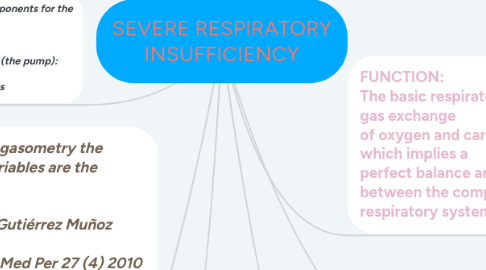SEVERE RESPIRATORY INSUFFICIENCY
by Juliana Ramirez


1. Related components for the function respiratory Musculature (the pump): Air ways: Alveolar units
1.1. CLASSIFICATION_ Severe respiratory insufficiency: Chronic respiratory failure: Heightened chronic respiratory failure:
2. In an arterial gasometry the measured variables are the following: Fernando R. Gutiérrez Muñoz 290 Minutes Med Per 27 (4) 2010 PaO2: 60-80 mmHg Arterial hypoxemia <60 mmHg Respiratory insufficiency PaCO2 : <35 mmHg Hypocapnia (alveolar hyperventilation) > 45 mmHg Hypercapnia (alveolar hypoventilation
2.1. The presence of hypercapnia or hypocapnia may whether or not accompanied by respiratory acidosis or alkalosis, that should be differentiated from acidemia (increased the concentration of hydrogen ions in the blood) and of Alkalemia (decreased ion concentration of hydrogen in the blood) respectively
3. Clinic history The diagnosis of acute respiratory failure part of the clinical suspicion, monitoring helps with pulse oximetry and its confirmation is based on the analysis of arterial gases and a physical examination is requested
3.1. nitial handling • Place the patient in semi-sitting position • Verify airway patency and need to intubate the patient • Administer oxygen through a Venturi mask with a FiO2 of 0.5 • Secure a permeable intravenous line with a catheter 20G or 18G peripheral • Place a nasogastric tube if there is distension gastric • Nebulisations with beta-agonists (salbutamol or fenoterol) if there is bronchospasm. • Consider the onset of prophylaxis with ranitidine and / or heparin • Consider initiation of specific therapy for the cause of respiratory failure • Determine the patient's admission to the ICU
4. FUNCTION: The basic respiratory function is gas exchange of oxygen and carbon dioxide; which implies a perfect balance and control between the components of the respiratory system
4.1. the insufficiency Respiratory is defined as the presence of hypoxemia arterial (PaO2 less than 60 mmHg), at rest, at level from the sea and breathing ambient air, accompanied or not of hypercapnia (PaCO2 greater than 45 mmHg). We will only call hypoxemia when PaO2 be find between 60 and 80 mmHg1,
5. Physiology of respiratory system components Nervous System: This is the control system, and comprises the dorsal and ventral nucleus of the control group spinal cord and its afferent and efferent nerves Associates
5.1. Physiology of gas exchange 2.5,9 The transport of O2 it is the product of cardiac output and of the amount of said gas contained in the blood.
6. symptom Dyspnea Wheezing, Cyanosis cough Alterations in oxygen saturation, Cardiovascular system disorders Neurological disorders
6.1. auxiliary exams clinical laboratory chest x-ray tac thorax electrocardiogram echocardiogram
6.1.1. treatment oxygen therapy ventilation control of vital signs and arterial gases
